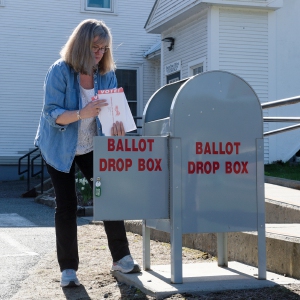Column: Climate change is real. Ask the insurance companies
| Published: 09-11-2023 1:34 PM |
This just in: Climate change is not a hoax! As I was this essay, the lead story on my phone’s news feed was “Hurricane Lee forecast to become strongest Atlantic storm so far this year.” Thursday’s Valley News featured a front-page picture of Judy Griffith, 73, wiping away sweat while sitting with friends outside Rogers House in Lebanon, noting that the National Weather Service had issued a heat advisory for Grafton County with temperatures expected to reach the mid-90s. One article in that paper reported that farmers in all counties in Vermont were eligible for federal aid to help compensate for losses incurred due to unexpected frosts in spring and the floods this summer. Another article reported that the World Meteorological Organization declared that last month was not only the hottest August scientists ever recorded, but it was also the second-hottest month ever measured, behind only July 2023 ... the previous month.
The New York Times’s Thursday coverage featured videos of floodwaters in Brazil and flooding in Greece and articles about the unexpected deluge that muddied the proceedings Burning Man; the return of 20,000 residents to Yellowknife, Canada, who fled when wildfires threatened that city; and Africa’s plea at a climate conference for developed nations to stop burning fossil fuels.
Hurricanes, heat waves, and wildfires are evidence that climate change exists, yet the full costs of climate change have not hit us yet: The costs of insurance that will be passed along to everyone directly and indirectly. And when those costs affect all of us, we will need to make some very tough choices.
Jacob Bogage’s Washington Post article, “Home insurers cut natural disasters from policies as climate risks grow,” describes how many homeowners insurance providers are refusing to offer policies that include coverage for natural disasters in risky areas. Instead of including coverage for climate-related events, the insurance industry is offering coverage for those occurrences through costly “riders.” As a result, homeowners in risky areas abandon homeowners insurance altogether due to the sky-high rates. In some cases, states with homeowners located in high-risk zones become the insurer of last resort.
Consequently, if or when their homes are destroyed by a hurricane or wildfire these uncovered homeowners will incur high out-of-pocket expenses to rebuild or be compelled to move elsewhere. Either decision will reduce the homeowner’s wealth. Should the homeowner leave, the towns, counties, and states will lose real estate revenues forcing them to either raise the taxes on homeowners who remain in their jurisdiction or make deep cuts to services.
Ultimately, those of us who live in relatively safe areas will be forced to pay higher rates to ensure the solvency of those companies who provide homeowners’ insurance and/or pay higher taxes so that the states we live in can provide insurance policies of last resort to residents who live in hazardous areas.
Florida offers an example of how this might play out. In Florida, because 14 insurance firms have either left the state as of April or have policy portfolios that are failing, the taxpayer-backed Citizens Property Insurance became the state’s second-largest insurer in 2021 in terms of policies written according to the Insurance Information Institute. Farmers, the fifth-largest homeowners’ insurance provider in the United States, said in July that it would not renew nearly a third of its policies in the Sunshine State. Will the state of Florida now insure those homeowners? If Hurricane Lee hits Florida will the state be able to cover the costs? If not, who will?
And the impact of increased insurance costs is not limited to homeowners. As Georgina Gustin reported in a recent Inside Climate News article, climate risks across the country are resulting in skyrocketing insurance costs for farmers as well. The Environmental Working Group, which has for decades critically scrutinized the Federal Crop Insurance Program, published new research last week finding that the cost of the program has soared from just under $3 billion in 2002 to just over $19 billion last year. The good news for farmers is that taxpayers have assumed 60% of this cost thanks to federal farm subsidies.
Article continues after...
Yesterday's Most Read Articles
 Dartmouth administration faces fierce criticism over protest arrests
Dartmouth administration faces fierce criticism over protest arrests
 Hanover house added to New Hampshire Register of Historic Places
Hanover house added to New Hampshire Register of Historic Places
 Sharon voters turn back proposal to renovate school
Sharon voters turn back proposal to renovate school
Looking at this predicament leads to only one conclusion: For insurance companies and states to remain fiscally solvent, everyone will need to share the costs for climate change. This conclusion, in turn, leads to some tough questions:
■Will we continue to provide federal funding to reconstruct houses in areas insurance companies deem unsafe?
■If a state fund serving as insurer of last resort is depleted due to climate-related catastrophes, will federal funds bail them out?
■Will the federal government adopt the regulations needed to mitigate climate change so that these costs can be contained?
■Will legislators support bills needed to enable the Executive branch to take the action needed to the costs associated with climate change?
The 2024 election provides voters with an opportunity to hear how each political party and each candidate intends to address these kinds of questions. Instead of wrestling with questions about Hunter Biden’s laptop, Joe Biden’s alertness, the timelines for the various trials facing Donald Trump, or who might become the GOP candidate should Donald Trump be convicted, voters might want candidates to spend time wrestling with questions related to the current and future costs associated with climate change. Some readers might believe climate change is a hoax. The insurance marketplace begs to differ. The time to address climate change is now.




 Editorial: Response to campus protests only adds fuel to the fire
Editorial: Response to campus protests only adds fuel to the fire Editorial: Chris Sununu’s moral vacuum
Editorial: Chris Sununu’s moral vacuum Editorial: Gambling tarnishes America’s sporting life
Editorial: Gambling tarnishes America’s sporting life By the Way: A white nationalist’s many mistruths
By the Way: A white nationalist’s many mistruths
